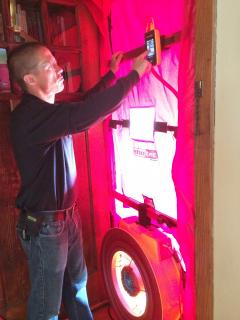While contractors and others in the home performance industry know all there is to know about our technical language, we realize that you, the homeowners, might not! This blog series - BPI Phrase of the Month - will attempt to define some of our industry's terminology. Have a word or phrase you want explained? Let us know and we'll write a post for you!
By now, you have probably heard someone talk about an energy assessment, audit or analysis, but do you know what it entails and why it works so well? Think of it this way: You realize you’re not feeling well so you go to the doctor. How would you like your doctor to handle your treatment? Would you want him to ask questions and run tests to find exactly what’s going on, or would you rather he takes one look at you and tells you it’s pneumonia? Obviously, the only way to get to the core of the issue is for the doctor to ask questions and perform tests.
That is what an energy audit is; or more accurately, it is a whole-house diagnostic assessment that looks at the house as a complex collection of systems using visual inspections and specific diagnostic equipment. Just like your body, a house is not a collection of independent components that never interact with each other. It’s all connected.
What is a blower door test?
Let’s focus on one specific piece of diagnostic equipment fundamental to all assessments – the blower door.
To further our analogy, just as people are all fundamentally built the same, we are all vastly different in the way we operate. Houses are no different. Two seemingly identical houses can behave very differently. The devil is in the details and the blower door can help unlock these hidden details.
During the assessment a blower door will be installed in an exterior doorway, after combustion appliances are turned off. The blower door depressurizes (pulls air out of) or pressurizes (pushes air into) the house, establishing a 50 Pascal pressure difference between the inside of the house and the outside – essentially simulating the pressure of a 20 MPH wind.
The result is a measure expressed in the amount of cubic feet of air the fan is moving every minute (e.g. 2,632 Cubic Feet per Minute (CFM)). The higher the number (based on a home’s size), the leakier it is and the more money you are wasting trying to heat or cool it. The goal of the blower door is to locate the specific cracks and gaps in your home, to identify where air sealing can be applied to reduce this leakage.
It’s no secret that air sealing typically provides the fastest payback for the investment and increased comfort rate. And it’s a lot more complicated than just caulking around windows, cracks and installing door sweeps. It involves sealing penetrations and pathways often hidden in the attic, basement and walls.
As an example, fiber glass insulation is found in millions of houses and is a great product when installed correctly. But do you know how it works? It’s not the strands of fiberglass, but rather the tiny dead-air pockets in between all those strands that reduce heat loss. If air is allowed to pass through the insulation, the effectiveness of the insulation drops off the charts and fast. So what may be listed as R-19 may be acting like R-4 depending on the amount of air circulating through it – and where that air is coming from. This is true for all fiber insulation.
Use of the blower door can help create an action plan to reduce the amount of air leaking from a house and can provide you with both comfort and peace of mind. Just remember, the blower door is one of many tools used during a whole house assessment. If your contractor is not looking at the house as a complex system, using diagnostic equipment, and only trying to sell you what they specialize in (windows, insulation, heating systems, etc.) you are doing your finances, your family, and yourself a major disservice.
Don’t be afraid to look online for videos of this diagnostic tool – there are hundreds (like this one). Knowledge is power. When you decide to take action to make your home a more comfortable and safe place, insist on a whole house assessment to get the most for your money.


Follow us